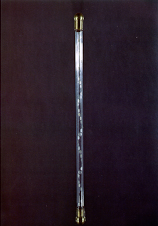
49 x 2.4
Glass, brass and tin leaf
CAT. 1851 : 30.J.III
Tubo fulminante.
Fulminant tube.
The experimental study of "electric fire" led to a series of scientific instruments of various kinds. The spectacular effects produced by electrical discharges in gaseous atmospheres can be observed in these experiments.
The apparatus on display here comprises a cylindrical glass tube inside another of the same length, but slightly wider. They are closed by pieces of metal. A spiral of separated small tin discs is fixed inside the inner tube. Two brass spheres are attached to the ends of the tube. When the instrument is held by one of the ends and the other brought near to the conductor of an electrostatic machine, a spark leaps between the conductor and the end near to it and points of light can be seen in the spaces between the tin discs as long as the spark is jumping the gap.
This type of tube was often used to observe electrical discharges in vacuum. The junctions between the brass pieces and the glass tube were usually insulated with lacquer, whilst some air was extracted from the tube by means of a vacuum pump. In these conditions, each tin disc was polarized as an electric dipole. There was, therefore, a sequence of electric dipoles such that the positive pole of one disc was next to the negative pole of the neighbouring disc.
Predictably, the tube shone with a fairly intense luminosity owing to the electrical discharges between the poles of opposite signs. This luminosity may have different configurations over the length of the tube according to the layout of the tin leaves, or varying with the shape of the recipient used. According to Cavallo the spectacle is very entertaining when observed in a dark room.
The example in the Gabinete de Física is described in the 1790 Index by dalla Bella under number 580, but it bears the inscription P.IV.602.
Sigaud de la Fond, Joseph-Aignan, Description et Usage d'un Cabinet de Physique Experimental, Paris, 1775, Vol. II, Pl. XXVI, Fig. 1.
Cavallo, Tiberius, Traité Complet d'Electricité, Paris, 1785.